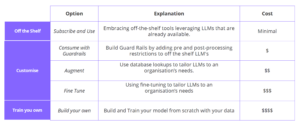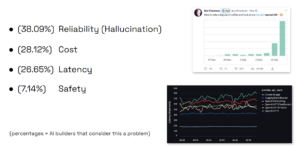Large language models (LLMs) are a type of artificial intelligence (AI) that are trained on massive amounts of text data. This allows them to generate text, translate languages, write different kinds of creative content, and answer your questions in an informative way. However, LLMs also present new challenges in production. In this article, we will discuss the challenges that enterprises are experiencing with LLMs in production. We will also discuss the different options that enterprises have for using LLMs.

Some of the challenges that enterprises are experiencing with LLMs in production include the following:
- Reliability: LLMs are complex systems, and they can be prone to errors. This can lead to problems such as generating incorrect or misleading information or crashing unexpectedly.
- Cost: LLMs require a lot of computing power to train and run. This can make them expensive to deploy in production.
- Security: LLMs are trained on large amounts of data, which can include sensitive information. If an attacker is able to gain access to an LLM, they could potentially use it to steal data or launch other attacks.
- Latency: LLMs can be slow to generate text, especially for complex tasks. This can be a problem for applications that require real-time responses, such as chatbots.
- Bias: LLMs are trained on large amounts of text data, which can reflect the biases of the people who wrote that data. This can lead to LLMs generating text that is biased or offensive.
- Interpretability: LLMs are complex systems, and it can be difficult to understand how they generate text. This can make it difficult to identify and fix problems with their output.
Despite these challenges, LLMs are a powerful tool that can be used to improve many aspects of our lives. As we continue to develop and use LLMs, we must be aware of the challenges they present to mitigate them and ensure their safe and responsible use.
When choosing an LLM, there are a few things to consider, such as cost, accuracy, and customization options. There are five basic approaches to using LLMs:

What are the Options for Enterprises
Option 1: Subscribe and Use
This is the most basic option. You can subscribe to a service that provides access to LLMs. This is a good option if you don’t have the resources to build and train your own LLMs.
Option 2: Consume with Guardrails
This option is a step up from subscribing and using. You can add pre- and post-processing restrictions to LLMs to make them more suitable for your needs. This is a good option if you want to add some control over how LLMs are used.
Option 3 : Augment:
You can use database lookups to tailor LLMs to your organization’s needs. This is a good option if you want to add more specific information to LLMs.
Option 4: Fine Tune:
Fine-tuning is a process of adapting a pre-trained language model (LLM) to a specific task or domain. It is done by training the model on a smaller dataset that is specific to the task or domain. This process can improve the model’s performance on the task or domain by making it more familiar with the specific vocabulary and grammar used in that context.
Option 5: Build your own:
Building your own LLM is a challenging but rewarding experience. It requires a deep understanding of machine learning and natural language processing and access to a large amount of data. However, the results can be incredibly powerful. With a custom LLM, you can create applications that are tailored to your specific needs and requirements.
Each option has its own advantages and disadvantages. The best option for you will depend on your specific needs and resources. No matter which option you choose, LLMs can be a powerful tool for improving your organization’s productivity and capabilities. In the next blog, I will write more detail about each of these options and the pros and cons of each one.

